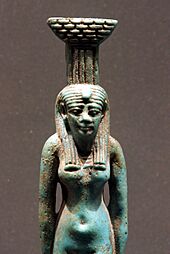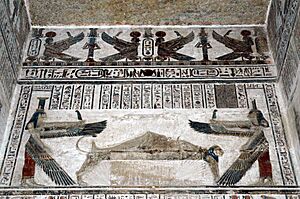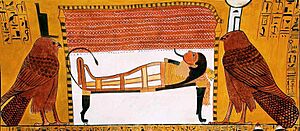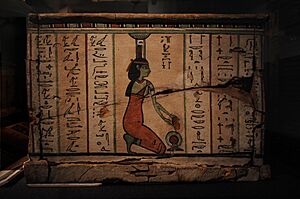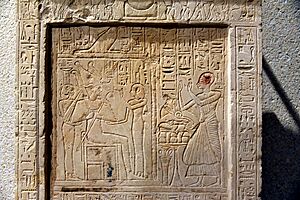Nephthys facts for kids
Quick facts for kids Nephthys |
|
|---|---|
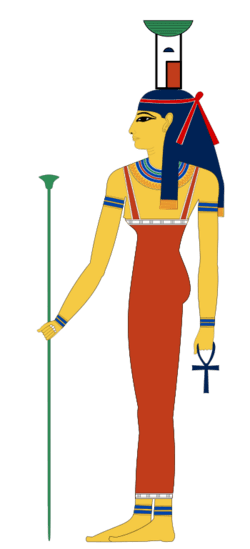
Nephthys was normally portrayed as a young woman, wearing a headdress in the shape of a house and basket
|
|
| Major cult center | None specifically, Diospolis Parva |
| Symbol | The sacred temple enclosure |
| Personal information | |
| Consort | Set, Osiris, Horus, (in some myths) Anubis (in Nubia) |
| Offspring | Anubis, Wepwawet, Horus (in some myths) |
| Parents | Geb and Nut |
| Siblings | Isis, Osiris, Haroeris, and Set |
Nephthys or Nebet-Het in ancient Egyptian (Greek: Νέφθυς) was a goddess in ancient Egyptian religion. She was a daughter of Nut and Geb. Nephthys was typically paired with her sister Isis in funerary rites because of their role as protectors of the mummy and the god Osiris and as the sister-wife of Set.
She was associated with mourning, the night/darkness, service (specifically temples), childbirth, the dead, protection, magic, health, embalming, and beer.
Contents
Function
Nephthys is the sister of Isis and companion of the war-like deity, Set. As sister of Isis and especially Osiris, Nephthys is a protective goddess who symbolizes the death experience, just as Isis represented the birth experience. Nephthys was known in some ancient Egyptian temple theologies and cosmologies as the "Helpful Goddess" or the "Excellent Goddess". These late ancient Egyptian temple texts describe a goddess who represented divine assistance and protective guardianship.
Nephthys is regarded as the mother of the funerary deity Anubis (Inpu) in some myths. Alternatively Anubis appears as the son of Bastet or Isis. In Nubia, Nephthys was said to be the wife of Anubis.
Though usually considered the aunt of Horus, she often appears as his mother. She is also seen as a wife of Horus. As the primary "nursing mother" of the incarnate pharaonic god, Horus, Nephthys also was considered to be the nurse of the reigning pharaoh himself. Though other goddesses could assume this role, Nephthys was most usually portrayed in this function. In contrast, Nephthys is sometimes featured as a rather ferocious and dangerous divinity, capable of incinerating the enemies of the pharaoh with her fiery breath.
Nephthys was typically paired with her sister Isis in funerary rites because of their role as protectors of the mummy and the god Osiris and as the sister-wife of Set.
Symbolism
In the funerary role, Nephthys often was depicted as a kite or as a woman with falcon wings, usually outstretched as a symbol of protection. She was, almost without fail, depicted as crowned by the hieroglyphs signifying her name, which were a combination of signs for the sacred temple enclosure (ḥwt) along with the sign for nb or mistress (lady) on top of the enclosure sign.
Nephthys was clearly viewed as a morbid-but-crucial force of heavenly transition, i.e., the pharaoh becomes strong for his journey to the afterlife through the intervention of Isis and Nephthys. The same divine power could be applied later to all of the dead, who were advised to consider Nephthys a necessary companion. According to the Pyramid Texts, Nephthys, along with Isis, was a force before whom demons trembled in fear and whose magical spells were necessary for navigating the various levels of Duat.
Mythology and position in the pantheon
Nephthys assists Isis in gathering and mourning the body of Osiris after his murder by the envious Set. Nephthys also serves as the nursemaid and watchful guardian of the infant Horus. The Pyramid Texts refer to Isis as the "birth-mother" and to Nephthys as the "nursing-mother" of Horus. Nephthys was attested as one of the four "Great Chiefs" ruling in the Osirian cult center of Busiris in the Delta and she appears to have occupied an honorary position at the holy city of Abydos.
As a mortuary goddess like Isis, Neith, and Serqet, Nephthys was one of the protectresses of the canopic jars of Hapi. Hapi, one of the sons of Horus, guarded the embalmed lungs. Thus we find Nephthys endowed with the epithet "Nephthys of the Bed of Life" in direct reference to her regenerative priorities on the embalming table. In the city of Memphis, Nephthys was duly honored with the title "Queen of the Embalmer's Shop" and there associated with the jackal-headed god Anubis as patron.
Nephthys could also appear as one of the goddesses who assists at childbirth. An ancient Egyptian myth preserved in the Papyrus Westcar recounts the story of Isis, Nephthys, Meskhenet, and Heqet as traveling dancers in disguise, assisting the wife of a priest of Amun-Re as she prepares to bring forth sons who are destined for fame and fortune.
Nephthys's healing skills and status as direct counterpart of Isis, steeped, as her sister in "words of power", are evidenced by the abundance of faience amulets carved in her likeness and by her presence in a variety of magical papyri that sought to summon her famously altruistic qualities to the aid of mortals.
Chief goddess of Nome VII
Nephthys was considered the unique protectress of the Bennu bird. This role may have stemmed from an early association in her native Heliopolis which was renowned for its "House of the Bennu" temple. In this role, Nephthys was given the name "Nephthys-Kheresket" and a wealth of temple texts from Edfu, Dendera, Philae, Kom Ombo, El Qa'la, Esna, and others corroborate the late identification of Nephthys as the supreme goddess of Upper Egyptian Nome VII, where another shrine existed in honor of the Bennu. Nephthys also was the goddess of the "Mansion of the Sistrum" in Hwt-Sekhem (Gr. Diospolis Parva), the chief city of Nome VII. There, Nephthys was the primary protectress of the resident Osirian relic, of the Bennu Bird, and of the local Horus/Osiris manifestation, the god Neferhotep.
Nephthys was most widely and usually worshiped in ancient Egypt as part of a consortium of temple deities. Therefore, it should not be surprising that her cult images could likely be found as part of the divine entourage in temples at Kharga, Kellis, Deir el-Hagar, Koptos, Dendera, Philae, Sebennytos, Busiris, Shenhur, El Qa'la, Letopolis, Heliopolis, Abydos, Thebes, Dakleh Oasis, and indeed throughout Egypt. In most cases, Nephthys found her typical place as part of a triad alongside Osiris and Isis, Isis and Horus, Isis and Min, or as part of a quartet of deities.
Images for kids
See also
 In Spanish: Neftis para niños
In Spanish: Neftis para niños


